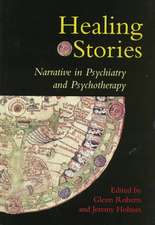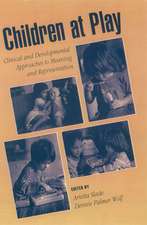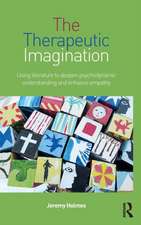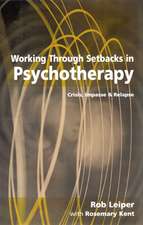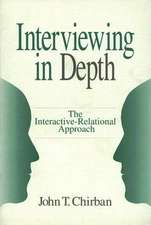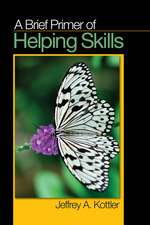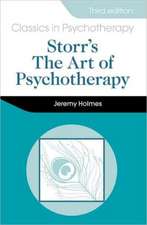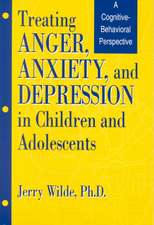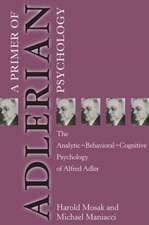Attachment in Therapeutic Practice
Autor Jeremy Holmes, Arietta Sladeen Limba Engleză Paperback – 4 dec 2017
The book covers:
- The history, research base, and key figures and concepts of attachment theory
- The key concepts of attachment theory, and their implications for practice
- Neuroscience implications of attachment and its therapeutic relevance
- The parallels and differences between parent-child attachment and the therapeutic relationship
- The application of attachment in adult individual psychotherapy across a number of settings, also to couples and families
- The applications of attachment to working with complex disorders
- The applications of attachment in child psychotherapy
| Toate formatele și edițiile | Preț | Express |
|---|---|---|
| Paperback (1) | 316.85 lei 3-5 săpt. | +25.19 lei 7-13 zile |
| SAGE Publications – 4 dec 2017 | 316.85 lei 3-5 săpt. | +25.19 lei 7-13 zile |
| Hardback (1) | 867.77 lei 6-8 săpt. | |
| SAGE Publications – 4 dec 2017 | 867.77 lei 6-8 săpt. |
Preț: 316.85 lei
Nou
Puncte Express: 475
Preț estimativ în valută:
60.63€ • 63.18$ • 50.20£
60.63€ • 63.18$ • 50.20£
Carte disponibilă
Livrare economică 13-27 martie
Livrare express 27 februarie-05 martie pentru 35.18 lei
Preluare comenzi: 021 569.72.76
Specificații
ISBN-13: 9781473953291
ISBN-10: 1473953294
Pagini: 240
Dimensiuni: 170 x 242 x 19 mm
Greutate: 0.45 kg
Ediția:First Edition
Editura: SAGE Publications
Colecția Sage Publications Ltd
Locul publicării:London, United Kingdom
ISBN-10: 1473953294
Pagini: 240
Dimensiuni: 170 x 242 x 19 mm
Greutate: 0.45 kg
Ediția:First Edition
Editura: SAGE Publications
Colecția Sage Publications Ltd
Locul publicării:London, United Kingdom
Recenzii
Two extraordinary clinicians with decades of research and writing on attachment worked with immense application and skill to distill what is essential in attachment theory and brought it to psychotherapeutic practice. The result is an exceptionally comprehensive and profound work of lasting value for every clinician – regardless of orientation. The book is a guide to improving the practice of the most experienced therapists at the same time as offering the friendliest and most accessible of introduction to this complex field. It is a remarkable achievement from two of the most sophisticated and respected authors on the clinical application of attachment theory. It provides a vivid picture of the process of bonding and lifelong transformation which attachment theory inspired therapy can bring. The book is for everyone who is serious about working psychotherapeutically and will not be bettered as an introduction for many many years to come
Holmes and Slade have provided exactly what the mental health professions have needed—a comprehensive examination of how attachment theory informs psychotherapy that is entirely accessible to beginner therapists, but also highly informative to seasoned clinicians. This superb text deserves a place on the shelves of every psychotherapist.
This book is a ticket to journey along with Jeremy Holmes and Arietta Slade as they describe their sophisticated and creative views on attachment theory, research and the co-created space of the therapist-patient relationship. With the addition of evocative and varied clinical vignettes it's as if one is being personally invited into the consulting rooms of these two gifted clinicians to hear how they use an attachment perspective to inform their work. This book is indispensable to both the clinical apprentice and the seasoned practitioner.
The authors tell us ‘Despite exuberance of theory, once in the consulting room, psychotherapy is a practice in search of a theory.’ But we have theory! (I for instance studied first cognitive-behavioural, then systemic, then psychoanalytic theory; all are useful, what more do you want?) Also, as an attachment researcher and writer, I thought I would know the field. But this book draws together the history and cutting edges of attachment in ways that give really fresh angles on clinical experience. Learning attachment interviewing and coding, 25 years ago, added a powerful layer to my listening to patients (and to myself on the couch). Reading this book I am again shown that attachment theory and findings illuminate every other kind of clinical theory we use, and everyday life for good measure.
This is a very helpful mini-handbook for students as well as practitioners of attachment-based relational psychotherapy. It is written with many vignettes to explain concepts.
Holmes and Slade have provided exactly what the mental health professions have needed—a comprehensive examination of how attachment theory informs psychotherapy that is entirely accessible to beginner therapists, but also highly informative to seasoned clinicians. This superb text deserves a place on the shelves of every psychotherapist.
This book is a ticket to journey along with Jeremy Holmes and Arietta Slade as they describe their sophisticated and creative views on attachment theory, research and the co-created space of the therapist-patient relationship. With the addition of evocative and varied clinical vignettes it's as if one is being personally invited into the consulting rooms of these two gifted clinicians to hear how they use an attachment perspective to inform their work. This book is indispensable to both the clinical apprentice and the seasoned practitioner.
The authors tell us ‘Despite exuberance of theory, once in the consulting room, psychotherapy is a practice in search of a theory.’ But we have theory! (I for instance studied first cognitive-behavioural, then systemic, then psychoanalytic theory; all are useful, what more do you want?) Also, as an attachment researcher and writer, I thought I would know the field. But this book draws together the history and cutting edges of attachment in ways that give really fresh angles on clinical experience. Learning attachment interviewing and coding, 25 years ago, added a powerful layer to my listening to patients (and to myself on the couch). Reading this book I am again shown that attachment theory and findings illuminate every other kind of clinical theory we use, and everyday life for good measure.
This is a very helpful mini-handbook for students as well as practitioners of attachment-based relational psychotherapy. It is written with many vignettes to explain concepts.
Cuprins
Background: Attachment Science
Introduction
Attachment’s Principals and Principles
Attachment-informed Psychotherapy: Definition and Overview
Affect Regulation in Attachment and Psychotherapy
Sensitivity, Mirroring, and Play: Foundations of Attachment Security in Caregivers and Therapists
The Neuroscience of Parental Sensitivity
Mentalising
‘Earned Security’: Attachment and Resilience
‘Organised Insecurity’: Fostering Security through Therapeutic Conversations
‘Disorganised Insecurity’: Attachment Approaches to Complex Disorders
From Stasis to Movement: An Attachment Model of Psychotherapeutic Change
The Improbable Profession: An Attachment-Bayesian Model of Psychodynamic Change
Attachment, Mentalising, and Child Psychotherapy: Working with Parents
Attachment in Couples and Families
Attachment and Society
Epilogue
Selected Attachment Bibliography
References
Introduction
Attachment’s Principals and Principles
Attachment-informed Psychotherapy: Definition and Overview
Affect Regulation in Attachment and Psychotherapy
Sensitivity, Mirroring, and Play: Foundations of Attachment Security in Caregivers and Therapists
The Neuroscience of Parental Sensitivity
Mentalising
‘Earned Security’: Attachment and Resilience
‘Organised Insecurity’: Fostering Security through Therapeutic Conversations
‘Disorganised Insecurity’: Attachment Approaches to Complex Disorders
From Stasis to Movement: An Attachment Model of Psychotherapeutic Change
The Improbable Profession: An Attachment-Bayesian Model of Psychodynamic Change
Attachment, Mentalising, and Child Psychotherapy: Working with Parents
Attachment in Couples and Families
Attachment and Society
Epilogue
Selected Attachment Bibliography
References
Descriere
A concise, accessible introduction to the basic principles of attachment theory, and their application to therapeutic practice

